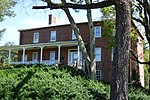Sycamore Dale
1839 establishments in VirginiaAmerican Civil War sites in West VirginiaBuildings and structures in Romney, West VirginiaGreek Revival houses in West VirginiaHampshire County, West Virginia, in the American Civil War ... and 5 more
Houses completed in 1839Houses in Hampshire County, West VirginiaHouses on the National Register of Historic Places in West VirginiaNational Register of Historic Places in Hampshire County, West VirginiaPlantation houses in West Virginia

Sycamore Dale (also known as the Gibson-Wirgman-Williams House) is a 19th-century Greek Revival plantation house overlooking the South Branch Potomac River southwest of Romney, West Virginia. Sycamore Dale is one of several historic estates along South Branch River Road (County Route 8). It was listed on the National Register of Historic Places on December 2, 1980.
Excerpt from the Wikipedia article Sycamore Dale (License: CC BY-SA 3.0, Authors, Images).Sycamore Dale
South Branch River Road,
Geographical coordinates (GPS) Address Nearby Places Show on map
Geographical coordinates (GPS)
| Latitude | Longitude |
|---|---|
| N 39.3375 ° | E -78.773333333333 ° |
Address
South Branch River Road 2
26757
West Virginia, United States
Open on Google Maps







